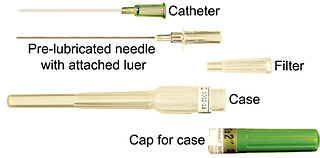Fetal distress refers to the presence of signs in a pregnant woman—before or during childbirth—that suggest that the fetus may not be well. Because of its lack of precision, the term is eschewed in modern American obstetrics.

Cardiotocography (CTG) is a technical means of recording the fetal heartbeat and the uterine contractions during pregnancy. The machine used to perform the monitoring is called a cardiotocograph, more commonly known as an electronic fetal monitor (EFM).

Umbilical cord prolapse is when, during labor, the umbilical cord comes out of the uterus with or before the presenting part of the baby. The concern with cord prolapse is that pressure on the cord from the baby will compromise blood flow to the baby.
Labor induction is the process or treatment that stimulates childbirth and delivery. Inducing labor can be accomplished with pharmaceutical or non-pharmaceutical methods. In Western countries, it is estimated that one quarter of pregnant women have their labor medically induced with drug treatment. Inductions are most often performed either with prostaglandin drug treatment alone, or with a combination of prostaglandin and intravenus oxytocin treatment.
Tocolytics are medications used to suppress premature labor. Tocolytic therapy is provided when delivery would result in premature birth, postponing delivery long enough for the administration of glucocorticoids, which accelerate fetal lung maturity but may take one to two days before its effects are seen.
Cervical dilation is the opening of the cervix, the entrance to the uterus, during childbirth, miscarriage, induced abortion, or gynecological surgery. Cervical dilation may occur naturally, or may be induced by surgical or medical means.
Uterine rupture is a when the muscular wall of the uterus tears during pregnancy or childbirth. Symptoms while classically including increased pain, vaginal bleeding, or a change in contractions are not always present. Disability or death of the mother or baby may result.
A contraction stress test (CST) is performed near the end of pregnancy to determine how well the fetus will cope with the contractions of childbirth. The aim is to induce contractions and monitor the fetus to check for heart rate abnormalities using a cardiotocograph. A CST is one type of antenatal fetal surveillance technique.
In medicine, a sound, also called a sonde, is an instrument for probing and dilating passages within the body, the best-known examples of which are urethral sounds and uterine sounds.

Balloon tamponade usually refers to the use of balloons inserted into the esophagus, stomach or uterus, and inflated to alleviate or stop refractory bleeding.

Prostaglandin E2 (PGE2), also known as dinoprostone, is a naturally occurring prostaglandin which is used as a medication. As a medication it is used in labor induction, bleeding after delivery, termination of pregnancy, and in newborn babies to keep the ductus arteriosus open. In babies it is used in those with congenital heart defects until surgery can be carried out. It may be used within the vagina or by injection into a vein.
Uterine atony is a loss of tone in the uterine musculature. Normally, contraction of the uterine muscles during labor compresses the blood vessels and reduces flow, thereby increasing the likelihood of coagulation and preventing hemorrhage. A lack of uterine muscle contraction, however, can lead to an acute hemorrhage, as the uterine blood vessels are not sufficiently compressed. Clinically, 75-80% of postpartum hemorrhages are due to uterine atony.

A bicornuate uterus or bicornate uterus, is a type of Mullerian anomaly in the human uterus, where there is a deep indentation at the fundus (top) of the uterus.
Couvelaire uterus is a life-threatening condition in which loosening of the placenta causes bleeding that penetrates into the uterine myometrium forcing its way into the peritoneal cavity.

Roberto Caldeyro-Barcia was a Uruguayan doctor who pioneered the field of maternal-fetal medicine, or perinatology. His research with Dr. Hermógenes Alvarez created Montevideo units, a measure of uterine performance during labor. He was a founding editor of the Journal of Perinatal Medicine, a widely published author, a lecturer, and as of 2010 the only Uruguayan to be nominated for a Nobel Prize.
Sonosalpingography (SSG), also known as Sion test, is a diagnostic procedure primarily used for evaluating patency of fallopian tubes. It was introduced as a screening procedure for infertility investigations. It is becoming more popular among practitioners due to absence of side effects.

Prolonged labor is the inability of a woman to proceed with childbirth upon going into labor. Prolonged labor typically lasts over 20 hours for first time mothers, and over 14 hours for women that have already had children. Failure to progress can take place during two different phases; the latent phase and active phase of labor. The latent phase of labor can be emotionally tiring and cause fatigue, but it typically does not result in further issues. The active phase of labor, on the other hand, if prolonged, can result in long term complications.
The postpartum physiological changes are those expected changes that occur to the woman's body after childbirth, in the postpartum period. These changes mark the beginning of the return of pre-pregnancy physiology and of breastfeeding. Most of the time these postnatal changes are normal and can be managed with medication and comfort measures, but in a few situations complications may develop. Postpartum physiological changes may be different for women delivering by cesarean section. Other postpartum changes, may indicate developing complications such as, postpartum bleeding, engorged breasts, postpartum infections.








